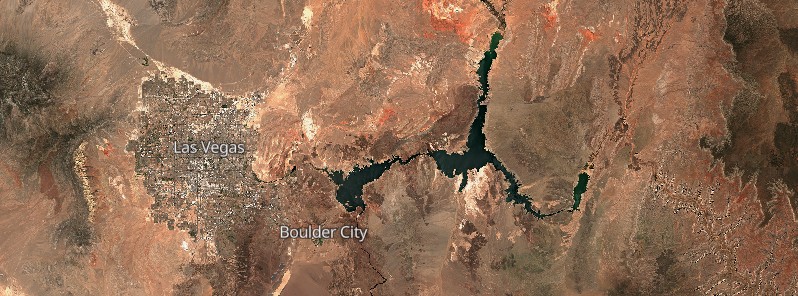Lake Mead hits record low, triggering its first-ever shortage declaration, U.S.

Water levels at Lake Mead have fallen to record lows this summer, prompting officials to declare the reservoir's first-ever water shortage on August 16, 2021. Lake Mead is a man-made reservoir on the Colorado River formed in the 1930s from damming the river at the Nevada-Arizona border — Hoover Dam. It's the largest reservoir in the United States, providing household water to 40 million people in Arizona, California, Nevada, and Mexico, and irrigation for large areas of farmland.
Given the ongoing historic drought and low runoff conditions in the Colorado River Basin, downstream releases from Glen Canyon Dam and Hoover Dam will be reduced in 2022 due to declining reservoir levels. In the Lower Basin, the reductions represent the first 'shortage' declaration – demonstrating the severity of the drought and low reservoir conditions.1
Based on projections made by the Bureau of Reclamation, Lake Mead’s January 1, 2022, elevation is expected to be 324.87 m (1 065.85 feet), which is about 2.74 m (9 feet) below the Lower Basin shortage determination trigger of 327.66 m (1 075 feet) and about 7.31 m (24 feet) below the drought contingency plan trigger of 332.23 m (1 090 feet).1
As a result, Lake Mead will operate in its first-ever Level 1 Shortage Condition in the calendar year 2022 — from January 1 through December 31, 2022.
This means Arizona will lose approximately 18% of the state's annual apportionment, Nevada 7%, and Mexico 5%.
Further rounds of cuts will be triggered if projected water levels drop to 320 m (1 049 feet), 318 m (1 043 feet), and 312 m (1 023 feet).
The cuts mean less water and tough allotment decisions for agriculture, cities, and Native American tribes in a region suffering historic — 22nd year of drought.2
"Although agriculture in some of the counties we serve will be affected, it is important to note that the drinking water that AWC serves its residential and business customers statewide will not be affected by the initial shortage declaration," the Arizona Water Company (AWC) said in a statement.3
"Equally important, is the strong water conservation ethic in Arizona communities across the state. Your local water conservation achievements have helped avoid this declaration for several years. We encourage all Arizonans to continue to do their part in securing our water future by using water wisely at home and at work."
Total Colorado River system storage is currently at a capacity of 40%, down from 49% at this time last year.
References:
1 Reclamation announces 2022 operating conditions for Lake Powell and Lake Mead – USBR
2 U.S. declares first Western reservoir water shortage, triggering cuts – Reuters
3 Arizona Water’s Response to Colorado River Shortage Declaration – AWC news release August 9, 2021
Featured image: Lake Mead on August 8, 2021. Credit: Copernicus EU/Sentinel-2, TW

Bill, you’d be better off taking water from the Mississippi…the upper Great Lakes output at Detroit is less than Ohio River Flow at Cincinnati…
You know, for all that money the US government wasted on that failed war in Afghanistan, they could have built a pipeline for water from the Great Lakes and shipped it to Nevada, Utah, and California. The Great Lakes are at their highest record in modern history.
Well, the Taliban likes driving captured US military equipment. Now readers can understand the definition of “opportunity costs”.